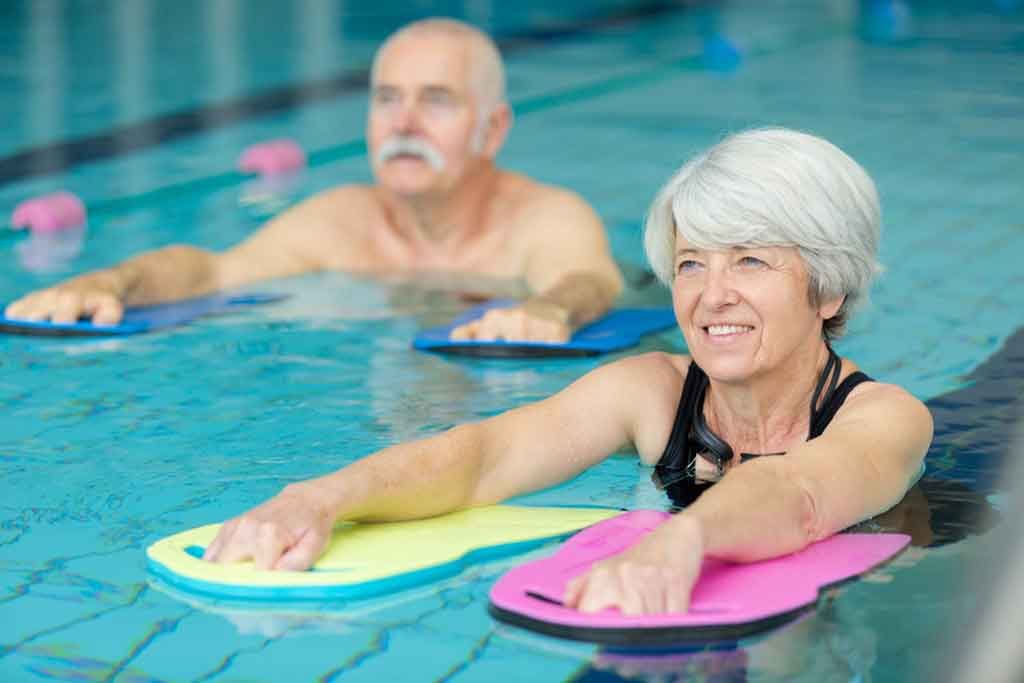8 of the Best Neuropathy-Friendly Exercises
Did you know that exercise is one of the best defenses against nerve damage and to promote healing? It’s always important, however, to play it safe. Check out these low-impact exercises, perfect for those fighting nerve damage.
It might seem a bit counterintuitive at first considering your nerve damage symptoms, but exercise is one of the best therapies you can do for your malfunctioning nerves. While you may not feel motivated for much movement, remaining sedentary will only promote further deterioration.
Benefits of Exercise, Beyond the Obvious
We’ll start with the physical.
Getting a consistent amount of exercise is a really great way to help your nerves stay as healthy and as functional as possible. When peripheral neuropathy starts to set in, it’s because your nerve endings are deteriorating faster than their central nerve bodies can respond to.
Those central nerve bodies are tasked with keeping your nerve endings (the parts that reach out to the ends of your hands and feet, for example) healthy. When the nerve endings get far away from those central bodies, the blood helps out by carrying healing nutrients and other reparative compounds to them. The more you exercise, the more you’re encouraging blood flow throughout your body. When you do this on a regular basis, you’re consistently delivering beneficial compounds and restorative nutrients to nerve endings in your hands and feet.
The results? Healthier nerves, better function, and less progression.
Get Yourself Some of Those Happy Hormones
The mental benefits are important too!
When you exercise, your body releases something called endorphins. These are basically your “happy hormones,” and they help you maintain a positive mood and keep you feeling great throughout the day. The more regularly you encourage the release of endorphins, the more consistently your body can use them as a mood-booster. And a mood-boost goes a pretty long way when peripheral neuropathy has caused constant pain, due to damaged nerves.
How to Keep Your Exercising Safe
It’s important to understand that peripheral neuropathy can cause something called secondary symptoms. This means that when your nerves stop working, other problems eventually arise, as a result.
Some of the most commonly seen symptoms of peripheral neuropathy are known as sensorimotor symptoms. This means that the nerves breaking down are a combination of both sensory and motor nerves, which impact your ability to feel and your ability to move, respectively.
This can have a few different dangerous implications when it comes to exercise.
Added Potential for Injury and Falls
For one thing, a loss of sensation in your lower extremities can make it easy to overlook injuries. Even a small cut can wind up developing a serious infection, which for severe cases of neuropathy can put you at a real risk for amputation, due to your compromised ability to heal. Loss of sensation in the lower extremities can also impact one’s gait, leading to the potential for things like joint misalignment, stress fractures, and so forth.
Another issue that can come along with peripheral neuropathy involves a loss of full muscle coordination in the extremities. This means that you won’t be able to move your feet and leg muscles as effectively as you would normally be able to, and even a small change in this direction can have an impact on your ability to walk. This often elevates risks for falls and trips.
Focus on Safer, Low-Impact Activities
Exercise is one of the best ways to work against the onslaught of peripheral neuropathy, but the name of the game is doing it in a way that won’t inadvertently worsen your condition. You want to, in other words, avoid activities that might be too high-impact, as well as ones that might put you at risk for falls or other injuries.
The following are eight low-impact, neuropathy-friendly exercises to get your blood flowing, chemistry more balanced, and restorative compounds out to your periphery. Perhaps equally important, exercise helps your body avoid the risk of further injury.
1. Swimming

When it comes to patients with peripheral neuropathy — at just about any level of severity — swimming is one of those all-around perfect exercises. Even more, it’s great for people at just about any level of fitness. All you really need to do is know how to swim!
You can swim as much or as little as you want, adjusting the workout to suit your relative capabilities. Either way, swimming is an effective full-body workout, yet with the benefit of minimal impact. This makes it not just one of the most effective, but also one of the safest exercises to enjoy with peripheral neuropathy.
You can also enjoy aerobic exercises in the shallow water if you prefer this method of water-borne exercise to some good, old-fashioned lap swimming. Water shoes or an old pair of sneakers might help you get a little traction and protection on the pool floor.
2. Yoga
Another highly beneficial physical activity, yoga is perfect for peripheral neuropathy patients due to its slow, patient, and graceful nature. And it doesn’t just offer physical benefits, either. Yoga comes with powerful mental and spiritual impacts, making it one of the most truly holistic forms of exercise around.
For just about anyone suffering from chronic discomfort, pain, limitations, and frustrations that can come with peripheral neuropathy, yoga is a top-notch choice for encouraging whole-body healing.
3. Walking

When it comes to outdoor exercise, a nice walk is a really great, lower-impact alternative to running. A treadmill works, too! The point here is that you can easily tailor the intensity of your walk to a level that suits your physical condition. So many people with peripheral neuropathy avoid walking. It’s understandable given the symptoms, but it’s not helping the problem. The more you walk, the better your body gets at doing it. Giving up only lets your body lapse into the more painful and less mobile later stages of peripheral neuropathy.
Give yourself small, incremental goals. Increase your distance or your speed just a little bit every time. Invest in a highly-cushioned walking shoe, or don a pair of fuzzy-lined Crocs, squishy Sketchers or comfy Allbirds to take the edge off, if need be.
4. Recumbent Stationary Bike
Any stationary bike is a great choice for low-impact exercise, but many actually prefer what’s known as a recumbent stationary bike. This is a design that offers an increased level of comfort, due to allowing the rider to adopt a more natural, seated position.
You can do this at the gym or in your own home — either way, a recumbent stationary bike workout is a highly effective method for improving circulation, without exposing your extremities to the potentially damaging shock and impact that can come along with an activity like running.
5. Tai Chi
Tai Chi is slightly similar to yoga — it’s a movement-based exercise, that focuses on slow motions and mostly avoids impact in the general sense. A Chinese martial art routine that consists of slow, graceful movements, Tai Chi is perfect for reducing stress, improving blood flow, building balance, and improving your posture.
Tai Chi is safe, comfortable, and easy to do just about anywhere, from the office to your bedroom, to just about any place in between.
6. Pilates

Low-impact is the name of the game when it comes to working out with peripheral neuropathy, and pilates is another great way to improve your core and muscle strength in a safe way.
We talked a bit earlier about how muscle weakness and loss of feeling in the extremities can lead to a heightened risk for falls and other injuries. Pilates works directly against that, helping you eliminate some of those potentially troubling secondary symptoms that can show up.
By concentrating on improving muscle strength and tone, specifically in the core, pilates helps build flexibility and muscle balance in a very concrete way. It’s great for those experiencing balance issues and can mitigate some of the risks of falls and further injuries.
7. Weight Lifting
Be sure, when lifting weights, not to overdo it. This activity is going to require a very honest assessment of your personal peripheral neuropathy situation. Don’t sign up for more than you can potentially handle.
When enjoyed safely and cautiously, though, weight lifting can be a great way to strengthen the muscles and beat back the damage wrought by peripheral neuropathy. Blood flow gets a boost and your muscle coordination will enjoy improvement, as well.
8. Rowing
Turns out you don’t need to live near a river to enjoy this one! Rowing is a great way to build core strength, and it can be done with minimal impact, making it safe and great for those with peripheral neuropathy.
Most of the time, the best way to access a rowing machine will be at your local gym; most have them. You can also get one for your home, as well. They’re not too tough to store when they aren’t in use, and used ones can even be found at a pretty decent bargain.
Find the Workout that Works Out for You
While exercise is always important, the presence of peripheral neuropathy arguably makes it more of a priority.
But here’s the thing — you’re also a human being, with your specific tastes and preferences. So if there’s an exercise that you just, plain don’t like doing…don’t do it! Working out should be something you ultimately can enjoy, so be sure to stick to what works for you.
The other big trick? Find ways to integrate your workout into an existing daily routine. This doesn’t have to be hard and only gets easier the more you actively try and find ways to do it. You might notice that a set of stairs is right next to the elevator you normally take when you show up to your office for work every day. Maybe you can simply park around the block and give yourself a brisk walk every morning and evening.
Don’t be afraid to get creative, or have a little fun with it, either! The more enjoyable your workout is to execute, the more you’ll find yourself looking forward to it (and its healthy after-effects) each day.
No matter how you do it, though, all that exercise is going to be great for your nerves. Getting a regular workout means you’re able to improve your blood flow, strengthen your muscles, and generally encourage healing.
Top 4 Reasons Why Olive Oil May Benefit Nerves

Extra-virgin olive oil may hold secrets to not only peripheral nerve health but central nerve…
Celiac Disease and the Neuropathy Connection: What You Need to Know

Notice that you get headaches more often than usual? Feel tired even though you sleep…
Up to Half of Pain Sufferers Experience Depression or Anxiety: Is this you?

You wake up every morning with pain, and you go to bed feeling the same…
66% of Chronic Drinkers Have Alcoholic Neuropathy

Chronic alcohol consumption is a contributing factor in a high number of peripheral neuropathy cases.…